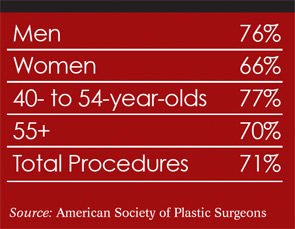Some patients, however, absolutely do not want a visible surgical scar. For them, an intraoral approach may be best. Physicians who use the intraoral approach on a regular basis say that the risk of infection is minimal—and that the intraoral approach improves the physician’s ability to fully visualize the region and place the implant. “With an intraoral incision, there is generally better exposure of the area because you don’t have to worry about scarring,” Dr. Kaufman said. “You can also be careful not to over-elevate the muscles of the chin and easily protect the nerves that supply sensation to the chin and lower lip.”
Explore This Issue
August 2012The type of implant used will depend on the patient, the degree of augmentation required and physician preference. “I prefer anatomic, silicone-based implants,” Dr. Funk said. “They look natural, slip in easily and sit very well on the jaw line.” Dr. Dayan prefers Mersilene mesh implants. Whether or not to fixate the implant is a decision that is also based on the type of implant and physician preference.
Genioplasty
A sliding genioplasty, which advances the mandible forward, may be an option for patients who desire chin augmentation but don’t want a foreign material inserted into their chin. Few otolaryngologists perform genioplasties; the procedure is usually done by a maxillofacial surgeon instead.
Increases in Chin Augmentations 2011 vs. 2010

Fillers
Facial fillers, including Restylane, Juve-derm and Radiesse, may be used to temporarily augment the chin. Some facial plastic surgeons use fillers to let patients “try out” chin augmentation or offer them as a less costly alternative to chin implantation.
“I think fillers are an excellent choice for patients who want to see what a chin implant would do for them,” Dr. Dayan said. “They’re so simple and easy to use; within five minutes, I can have someone walk out my door and look as if they’ve had a chin implant. The effect generally lasts a year to a year-and-a-half, so patients can get an idea of what a chin implant would do for them. If they don’t like it, the filler simply goes away. If they want to remove it, I can remove it using a reversal agent. If they do like it, they may consider having a chin implant in the future.”
Other physicians, though, aren’t sold on the idea of using facial fillers for chin augmentation. “I think there may be a role for fillers—maybe for minor camouflage issues after surgery or in someone who isn’t a candidate for surgery. But I think that a lot of plastic surgeons would agree that the chin is a very complex anatomical area and that there has to be a great level of care taken to avoid contour irregularities with the injections of fillers,” Dr. Kaufman said.
Leave a Reply